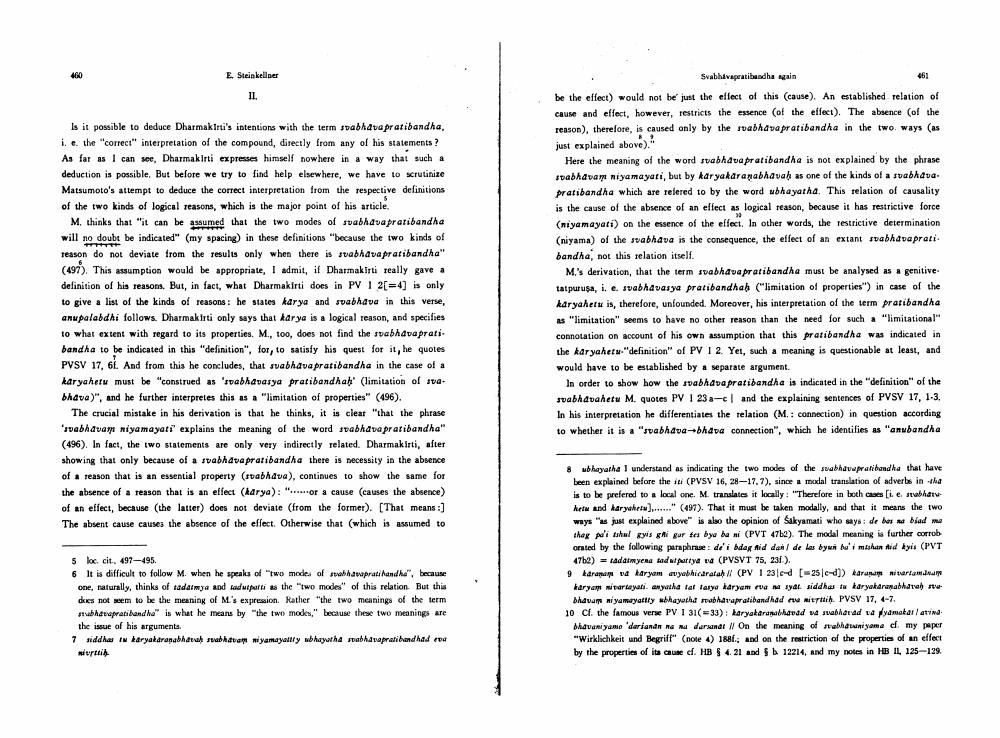Book Title: Svabhavarat Bandha Again Author(s): Ernat Steinkellner Publisher: Ernat Steinkellner View full book textPage 3
________________ E Steinkeller Is it possible to deduce Dharmakini's intentions with the term sabhava pratibandha, i. e. the correct" interpretation of the compound, directly from any of his statements ? As far as I can see, Dharmakinti expresses himself nowhere in a way that such a deduction is possible. But before we try to find help elsewhere, we have to scrutinize Matsumoto's attempt to deduce the correct interpretation from the respective definitions of the two kinds of logical reasons, which is the major point of his article. M. thinks that it can be assumed that the two modes of wabhava pratibandha will no doubt be indicated" (my spacing) in these definitions "because the two kinds of Teason do not deviate from the results only when there is sabhava pratibandha" (497). This assumption would be appropriate, I admit, if Dharmak Irti really gave a definition of his reason. But, in fact, what Dharmakiri does in PV I 2-4) is only to give a list of the kinds of reasons: he states karya and swabhave in this verse, anupalabdhi follows. Dharmakirti only says that karya is a logical reason, and specifies to what extent with regard to its properties. M., too, does not find the sabhava prati bandha to be indicated in this "definition", for, to satisfy his quest for it, he quotes PVSV 17, 6. And from this he concludes, that sabhava pratibandha in the case of a karyahetu must be "construed as 'rvabhavarya pratibandhah' (limitation of sabhava)", and he further interpretes this as a "limitation of properties" (496). The crucial mistake in his derivation is that he thinks, it is clear that the phrase vabhavam niya mayati' explains the meaning of the word swabhava pratibandha" (496). In fact, the two statements are only very indirectly related. Dharmakinti, after showing that only because of a rvabhava pratibandha there is necessity in the absence of a reason that is an essential property (svabhava), continues to show the same for the absence of a reason that is an effect (karya): "...or a cause (causes the absence) of an effect, because the latter) does not deviate (from the former). (That means:] The absent cause causes the absence of the effect. Otherwise that (which is assumed to Svabhavapratibandha gain be the effect) would not be just the effect of this (cause). An established relation of cause and effect, however, restricts the essence of the effect). The absence of the reason), therefore, is caused only by the rabhava pratibandha in the two ways (as just explained above)." Here the meaning of the word abhava pratibandha is not explained by the phrase Isabhavam niya mayati, but by Aaryakaragabhavab as one of the kinds of a suabhava pratibandha which are refered to by the word wbhayatha. This relation of causality is the cause of the absence of an effect as logical reason, because it has restrictive force (niya mayati) on the essence of the effect. In other words, the restrictive determination (niyama) of the rabhava is the consequence, the effect of an extant rabhaveprati bandha, not this relation itself M's derivation, that the term sabhava pratibandha must be analysed as a genitive tatpurus, i.e. svabhavasya pratibandhab ("limitation of properties") in case of the Aaryaherm is, therefore, unlounded. Moreover, his interpretation of the term praribandha as "limitation" seems to have no other reason than the need for such a "limitational connotation on account of his own assumption that this pratibandha was indicated in the karyahetu"definition" of PV I 2. Yet, such a meaning is questionable at least, and would have to be established by a separate argument. In order to show how the sabhava pratibandha is indicated in the definition of the svabhavahetu M. quotes PV I 23 a-c and the explaining sentences of PVSV 17, 1-3, In his interpretation he differentiates the relation (M. : connection) in question according to whether it is "svabhavabadva connection", which he identifies as "anwbandha 5 loc. cit. 497-495. 6. It is difficult to follow M. when he speaks of two modes of nulla prati hand , because one, naturally, thinks of wadainya and adult the "we made of this relation. But this des mot em to be the meaning of M's expresion Rather the two meaning of the term subhanapatibandha is what he means by the two modes," because these two meanings are the issue of his arguments. 7 siddha tu karyakararathah haan miyarmally why he rabbraprati handhad ubhyatha I understand as indicating the two modes of the wabharatibandha that have been explained before the iw (PVSV 16,28-17,7). since mula translation of adverbs in the is to be prefered to a local one. M translates it locally: "Therefore in both cases [ie sabharu kra and karyahetu)......" (497). That it must be taken modally, and that it means the two ways" just explained above is also the opinion of Sakyamati who says: de bos bied they pistal Eyi kigu ini bye Mwi (PVT 4710). The model meaning further corrob orated by the following paraphru di'i dag tid dan de weby Ni r d bis (PVT 47b2) = adamyen and party w (PVSVT 75, 231.). 9 kar karyam wyobhiarata (PV 1 230- (-25c-d)) tarassa stara karyop sa anuha taf large baryam N yd aiddhas ta karyerasabhare the bham kiyamaally where therapatihand had w i PVSV 17, 4-7. 10 dl the famous verse PV 1 31(33): karyakarusellend harada makatlarin Mhavariyana derinden derdi il on the meaning of n i ya d my paper "Wirklichkeit und Begriff (note ) 1881; and on the restriction of the properties of an effect by the properties of its uk HB 421 and 5 b 12214, and my note in HB IL 125-129.Page Navigation
1 2 3 4 5 6 7 8 9 10 11
